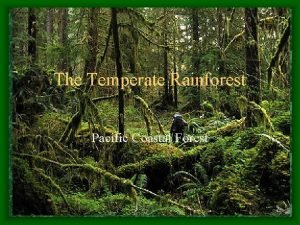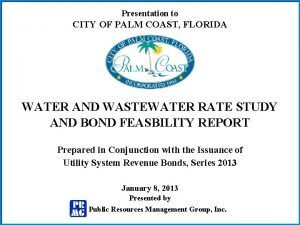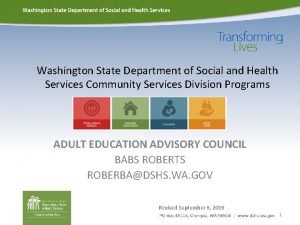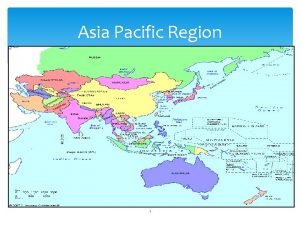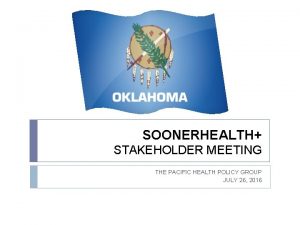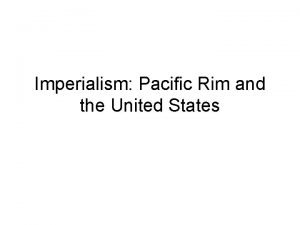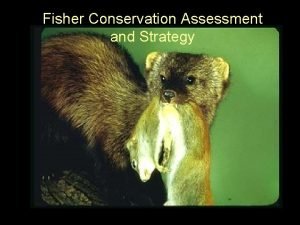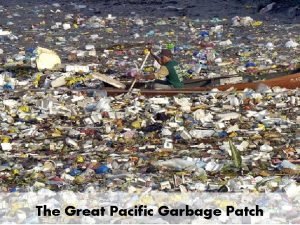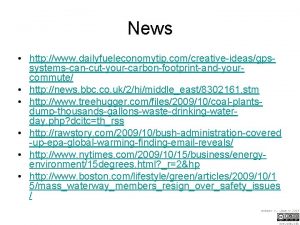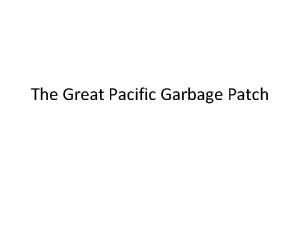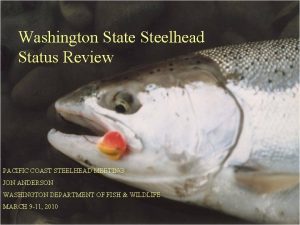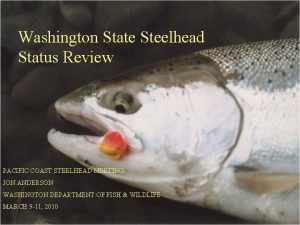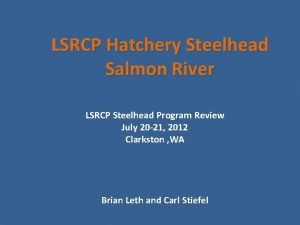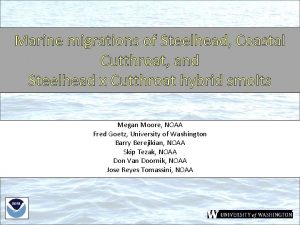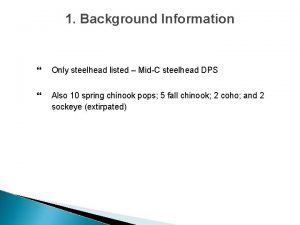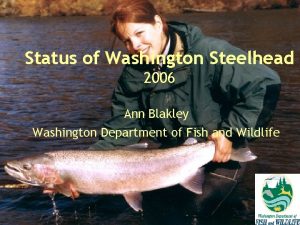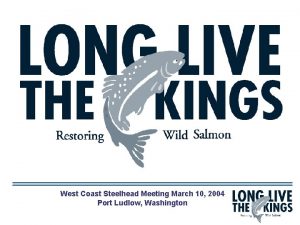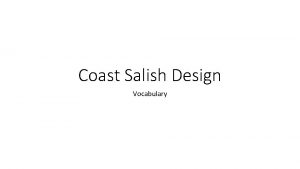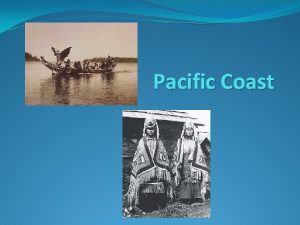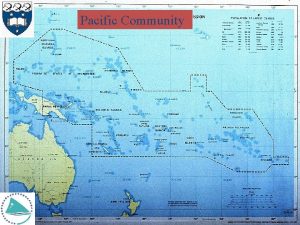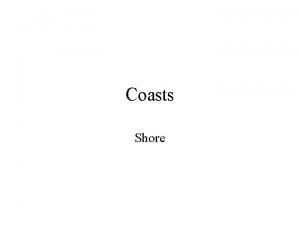PACIFIC COAST STEELHEAD MEETING AMILEE WILSON WASHINGTON DEPARTMENT










































- Slides: 42

PACIFIC COAST STEELHEAD MEETING AMILEE WILSON WASHINGTON DEPARTMENT OF FISH & WILDLIFE MARCH 2004 Washington State Steelhead Stock Status Review

NOAA Determination of Washington State Steelhead Status by ESU Ø Not Warranted for listing – Puget Sound (Coastal Steelhead) – Olympic Peninsula (Coastal Steelhead) – Southwest Washington (Coastal Steelhead) Ø Threatened – L. Columbia River Sys. (Coastal Steelhead) – M. Columbia River Sys. (Inland Steelhead) – Snake River Basin (Inland Steelhead) Ø Endangered – U. Columbia River Sys. (Inland Steelhead)


Which is it: SASSI or Sa. SI? SASSI (1992) Sa. SI (2002) Ø All anadromous species including Chinook, Chum, Coho, Pink, Sockeye, and Steelhead. Ø Salmon and Steelhead Stock Inventory Ø Inclusion of Bull Trout/Dolly Varden (1997) and Cutthroat Trout (2000) stock inventories. Ø Salmonid Stock Inventory

Salmonid Stock Breakdown for Washington State

Summary of 2002 Sa. SI Stock Ratings 1992: 137 stocks – – Healthy: 36 = 26% Depressed: 42 = 31% Critical: 1 = 1% Unknown: 58 = 42% 2002: 137 stocks – – – Healthy: 28 = 20% Depressed: 41 = 30% Critical: 1 = 1% Unknown: 66 = 48% Not Rated: 1 = 1% Note: The first three WA State Sa. SI ratings are only conceptually compatible with color-coded NOAA Fisheries ratings.

Summary of 2002 Sa. SI Stock Ratings

Puget Sound ESU – Not Warranted


Skagit River System (Puget Sound ESU) • Production in the mainstem & tributaries appears to be very poor at present • 1992 - Healthy; 2002 – Depressed or Unknown

Snohomish River System (Puget Sound ESU) • Strong system recovery from early eighties to consistently meet EG of 6500 until the year 1999 • Majority of stocks: 1992 - Healthy; 2002 - Depressed

Stillaguamish/Deer Creek (Puget Sound ESU) • 2002 status reflects improved overwintering habitat and increased parr-to-smolt survival and adult returns followin the flooding in 1995 • 1992 – Critical; 2002 - Depressed

Green River (Puget Sound ESU) • Escapements have generally varied within a range of 25% above or below the escapement goal of 2, 000 spawners. • 1992 – Healthy; 2002 - Healthy

Olympic Peninsula ESU – Not Warranted


Quillayute River (Olympic Peninsula ESU) • Historical bright spot for wild winter steelhead and seems to be maintaining good habitat • 1992 – Healthy; 2002 - Healthy

Queets River (Olympic Peninsula ESU) • No agreed to Esc. Goal • 1992 – Healthy; 2002 - Healthy


Quinault River (Olympic Peninsula ESU) • A wild stock with natural production • 1992 – Healthy; 2002 - Healthy

SW Washington ESU – Not Warranted


Humptulips River (SW Washington ESU) • Sustained a long decline, but seems to be stabilizing • 1992 – Healthy; 2002 – Depressed

Chehalis River (SW Washington ESU) • Escapements have been high and relatively stable from 2000 to 2003 • 1992 – Healthy; 2002 – Healthy

L. Columbia River ESU - Threatened


Toutle River (Lower Columbia River ESU) • Chronically low escapements from 1994 to 2001 • 1992 - Healthy; 2002 – Depressed

Lewis River (Lower Columbia River ESU) • Chronically low escapements; new escapement index established in 1997 but its relationship to the previous escapement index is currently unknown • 1992 – Depressed; 2002 – Depressed

Kalama River – (Lower Columbia River ESU) • Escapements in 1998 through 2001 have been only 14% to 33% of the goal • 1992 – Depressed; 2002 – Depressed

M. Columbia River ESU - Threatened


Touchet River (Mid Columbia ESU) • Data gaps hurt status determination • 1992 – Depressed; 2002 – Depressed

Yakima River (Mid Columbia River ESU) • Unexpected up turn in wild escapement • 1992 – Depressed; 2002 – Depressed

U. Columbia River ESU - Endangered


No Sa. SI Stock – (Upper Columbia ESU) Counts from Priest Rapids Dam represent all fish returning to the Upper Columbia River ESU

Methow/Okanogan Summer Steelhead (Upper Columbia ESU) • Counts from the Wells Dam • 1992 – Depressed; 2002 – Depressed

Snake River Basin ESU - Threatened


Tucannon River (Snake River Basin ESU) • Possible up-ward trend despite data gaps • 1992 – Depressed; 2002 – Depressed

Asotin Creek (Snake River Basin ESU) • Data gaps hurt status determination • 1992 – Depressed; 2002 – Depressed

Conclusions 1. Increase and maintain the number of Healthy stocks 1. How should we manage the 41 Depressed stocks? 2. Multitude of “Unknown” stocks – – Fisheries lost Harvest no longer a source of data 2 year steelhead moratorium Weather conditions make it impossible to survey most summer steelhead populations

 Steelhead oncology
Steelhead oncology Steelhead redd
Steelhead redd Riverbed steelhead wiki
Riverbed steelhead wiki Pacific temperate rainforest map
Pacific temperate rainforest map Palm coast sheriff
Palm coast sheriff City of palm coast water department
City of palm coast water department Washington state department of social and health services
Washington state department of social and health services Types of meeting
Types of meeting For todays meeting
For todays meeting Today meeting or today's meeting
Today meeting or today's meeting What is meeting and types of meeting
What is meeting and types of meeting Math department meeting agenda
Math department meeting agenda Meeting minutes
Meeting minutes Sers cte dual credit
Sers cte dual credit Toshiba asia pacific pte ltd
Toshiba asia pacific pte ltd Thought patterns for a successful career pacific institute
Thought patterns for a successful career pacific institute Pacific aviation marketing
Pacific aviation marketing Pacific theater timeline
Pacific theater timeline Ituc asia pacific
Ituc asia pacific Asia pacific region
Asia pacific region Atlantic pacific rule
Atlantic pacific rule Pacific health policy group
Pacific health policy group What is the asam assessment
What is the asam assessment Pacific strike team
Pacific strike team Pacific rim imperialism
Pacific rim imperialism Bia pacific fishner
Bia pacific fishner Schaeffler asia pacific
Schaeffler asia pacific Pacific garbage patch
Pacific garbage patch Pacific journalism review
Pacific journalism review Aggression in the pacific map
Aggression in the pacific map The great pacific garbage patch
The great pacific garbage patch Pacific northwest research station
Pacific northwest research station Where is the circum pacific belt located
Where is the circum pacific belt located Ccga pacific
Ccga pacific Australia the pacific realm and antarctica
Australia the pacific realm and antarctica Pacific arctic group
Pacific arctic group Pacific rim2 cda
Pacific rim2 cda Methalene
Methalene Pacific northwest gigapop
Pacific northwest gigapop East pacific rise
East pacific rise Garbage patch
Garbage patch Pacific lions club
Pacific lions club Why did western nations desire lands in the pacific rim?
Why did western nations desire lands in the pacific rim?



